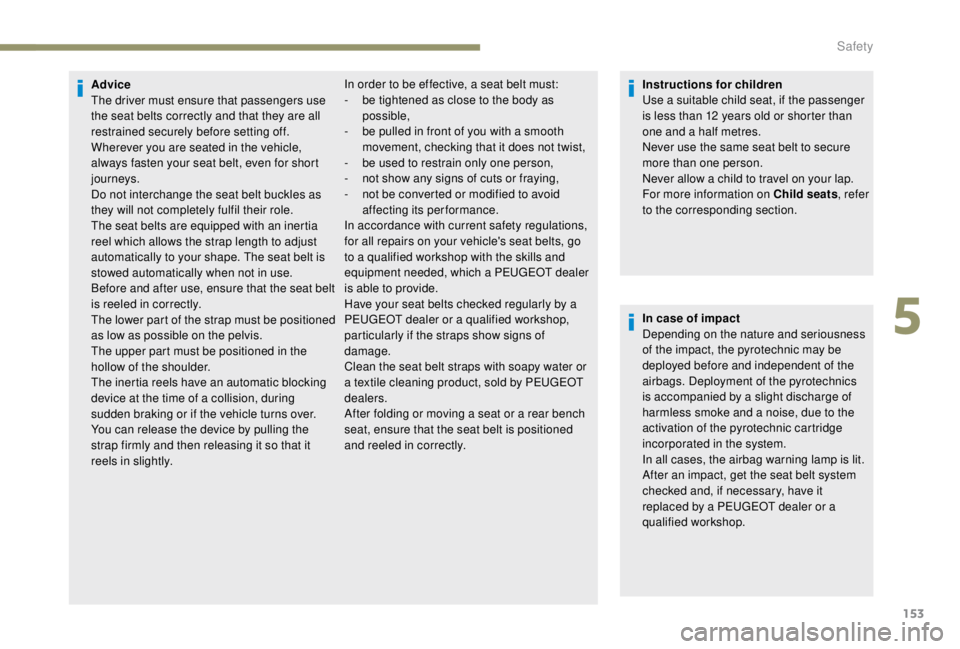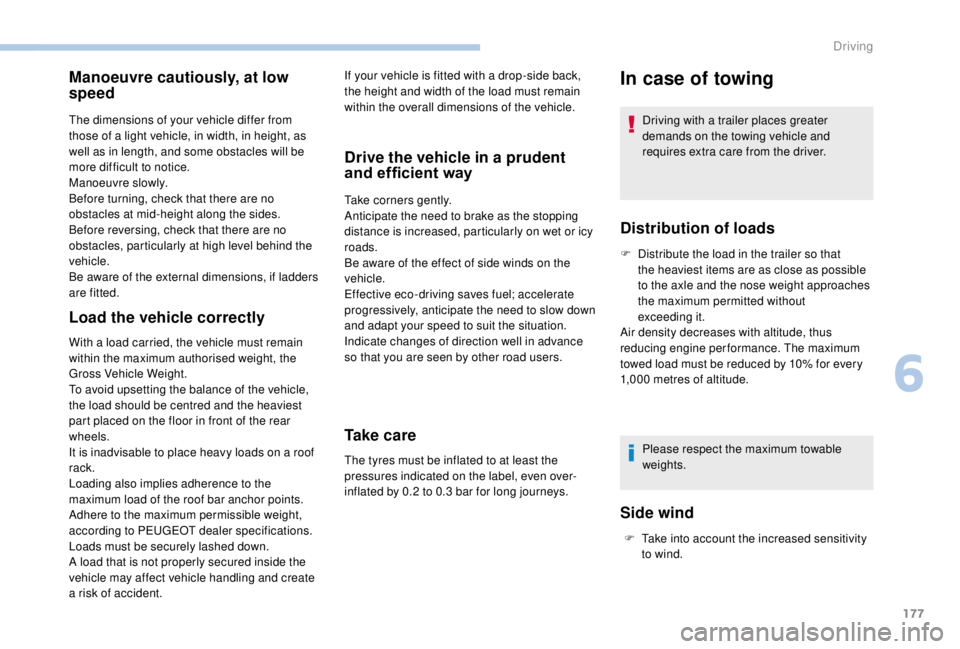Page 155 of 416

153
Advice
The driver must ensure that passengers use
the seat belts correctly and that they are all
restrained securely before setting off.
Wherever you are seated in the vehicle,
always fasten your seat belt, even for short
journeys.
Do not interchange the seat belt buckles as
they will not completely fulfil their role.
The seat belts are equipped with an inertia
reel which allows the strap length to adjust
automatically to your shape. The seat belt is
stowed automatically when not in use.
Before and after use, ensure that the seat belt
is reeled in correctly.
The lower part of the strap must be positioned
as low as possible on the pelvis.
The upper part must be positioned in the
hollow of the shoulder.
The inertia reels have an automatic blocking
device at the time of a collision, during
sudden braking or if the vehicle turns over.
You can release the device by pulling the
strap firmly and then releasing it so that it
reels in slightly.Instructions for children
Use a suitable child seat, if the passenger
is less than 12
years old or shorter than
one and a half metres.
Never use the same seat belt to secure
more than one person.
Never allow a child to travel on your lap.
For more information on Child seats , refer
to the corresponding section.
In case of impact
Depending on the nature and seriousness
of the impact, the pyrotechnic may be
deployed before and independent of the
airbags. Deployment of the pyrotechnics
is accompanied by a slight discharge of
harmless smoke and a noise, due to the
activation of the pyrotechnic cartridge
incorporated in the system.
In all cases, the airbag warning lamp is lit.
After an impact, get the seat belt system
checked and, if necessary, have it
replaced by a PEUGEOT dealer or a
qualified workshop.
In order to be effective, a seat belt must:
-
b e tightened as close to the body as
possible,
-
b
e pulled in front of you with a smooth
movement, checking that it does not twist,
-
b
e used to restrain only one person,
-
n
ot show any signs of cuts or fraying,
-
n
ot be converted or modified to avoid
affecting its performance.
In accordance with current safety regulations,
for all repairs on your vehicle's seat belts, go
to a qualified workshop with the skills and
equipment needed, which a PEUGEOT dealer
is able to provide.
Have your seat belts checked regularly by a
PEUGEOT dealer or a qualified workshop,
particularly if the straps show signs of
damage.
Clean the seat belt straps with soapy water or
a textile cleaning product, sold by PEUGEOT
dealers.
After folding or moving a seat or a rear bench
seat, ensure that the seat belt is positioned
and reeled in correctly.
5
Safety
Page 179 of 416

177
Manoeuvre cautiously, at low
speed
The dimensions of your vehicle differ from
those of a light vehicle, in width, in height, as
well as in length, and some obstacles will be
more difficult to notice.
Manoeuvre slowly.
Before turning, check that there are no
obstacles at mid-height along the sides.
Before reversing, check that there are no
obstacles, particularly at high level behind the
vehicle.
Be aware of the external dimensions, if ladders
are fitted.
Load the vehicle correctly
With a load carried, the vehicle must remain
within the maximum authorised weight, the
Gross Vehicle Weight.
To avoid upsetting the balance of the vehicle,
the load should be centred and the heaviest
part placed on the floor in front of the rear
wheels.
It is inadvisable to place heavy loads on a roof
rack.
Loading also implies adherence to the
maximum load of the roof bar anchor points.
Adhere to the maximum permissible weight,
according to PEUGEOT dealer specifications.
Loads must be securely lashed down.
A load that is not properly secured inside the
vehicle may affect vehicle handling and create
a risk of accident.
Drive the vehicle in a prudent
and efficient way
Take corners gently.
Anticipate the need to brake as the stopping
distance is increased, particularly on wet or icy
roads.
Be aware of the effect of side winds on the
vehicle.
Effective eco-driving saves fuel; accelerate
progressively, anticipate the need to slow down
and adapt your speed to suit the situation.
Indicate changes of direction well in advance
so that you are seen by other road users.
Take care
The tyres must be inflated to at least the
pressures indicated on the label, even over-
inflated by 0.2 to 0.3 bar for long journeys.
If your vehicle is fitted with a drop-side back,
the height and width of the load must remain
within the overall dimensions of the vehicle.
In case of towing
Driving with a trailer places greater
demands on the towing vehicle and
requires extra care from the driver.
Distribution of loads
F Distribute the load in the trailer so that
the heaviest items are as close as possible
to the axle and the nose weight approaches
the maximum permitted without
exceeding it.
Air density decreases with altitude, thus
reducing engine performance. The maximum
towed load must be reduced by 10% for every
1,000
metres of altitude.
Please respect the maximum towable
weights.
Side wind
F Take into account the increased sensitivity to wind.
6
Driving
Page 294 of 416
292
Battery capacity
Vehicle lengthRating in Ah
(Ampere hours)
Compact 480
Standard 640
Long 720
/ 800
Always replace the battery with one of
equivalent specification.
To w i n g
Procedure for having your vehicle towed or
for towing another vehicle using a removable
towing eye.
Access to the tools
For more information on the Tool box ,
refer to the corresponding section.
With a manual gearbox, move the gear
lever into neutral.
With an automatic or electronic gearbox,
place the gear selector into position N .
Failure to adhere to this specification
may lead to damage to braking system
components and the lack of braking
assistance on restarting the engine.
The towing eye is stowed in the tool box.
In the event of a breakdown
Page 297 of 416
295
Diesel EURO 5 engines and towed loads
Engines1.6 litre HDi 902 litre HDi 150
Gearbox Manual 5-speed (BVM5) Manual 6-speed (BVM6)Automatic 6-speed (EAT6)
Code DV6DUDW10F
Regulatory engine type BHVAHX
Length L1 , L 2L1*, L 2 *, L 3 * L1 , L 2L1*, L 2 *, L 3 * L1 , L 2L1*, L 2 *, L 3 *
Capacity (cm
3) 1,5 6 01,9 97
Max power: CEE standard (kW) 6611 0
Fuel Diesel
Braked trailer (within
the GTW limit) on a 12%
slope 2
seats 6001,1 0 0 800
3
seats 6001,1 0 0 800
Unbraked trailer 2-3
seats 600 750
Recommended nose
weight (kg)
or
Vertical load 2-3
seats 25 44 32
*
I
ncreased payload.
9
Technical data
Page 298 of 416
296
Diesel EURO 6.1 engines and towed loads
Engines1.6 litre BlueHDi
95 1.6
litre BlueHDi
95 S&S1.6
litre BlueHDi
115 S & S
Gearbox Manual 5-speed
(BVM5) Electronic 6-speed
(ETG6) Manual 6-speed
(BVM 6)
Code DV6FDUDV6FDUDV6FCU
Regulatory engine type BHVBHSBHX
Length L1 , L 2L1*, L 2 *, L 3 * L1 , L 2L1*, L 2 *, L 3 * L1 , L 2
Capacity (cm
3) 1,5 6 0
Max power: CEE standard (kW) 707085
Fuel Diesel
Braked trailer (within
the GTW limit) on a 12%
slope 2
seats 1,8 0 02,000 1,8 0 02,000 1,8 0 0
3
seats 1,8 0 02,000 1,8 0 02,000 1,8 0 0
Unbraked trailer 2-3
seats 750
Recommended nose
weight (kg)
or
Vertical load 2-3
seats7280 7280 72
*
I
ncreased payload.
Technical data
Page 299 of 416
297
Engines2 litre
BlueHDi 120 2
litre
BlueHDi
120 S&S2
litre
BlueHDi
15 0 S&S2
litre
BlueHDi
180 S&S
Gearbox Manual
6-speed (BVM 6) Manual
6-speed (BVM 6) Manual
6-speed (BVM 6) Automatic
6-speed ( E AT 6)
Code DW10FE DW10FEDW10FDDW10FC
Regulatory engine type AHK AHKAHXAHH
Length L1*, L 2 *, L 3 * L1*, L 2 *, L 3 *L1 , L 2L1*, L 2 *, L 3 * L1 , L 2L1*, L 2 *, L 3 *
Capacity (cm
3) 1,9 97
Max power: CEE standard (kW) 9011 0 13 0
Fuel Diesel
Braked trailer (within
the GTW limit) on a 12%
slope 2
seats 2,500 2,500 2,300 2,500 2,0002,200
3
seats 2,500 2,500 2,300 2,500 2,0002,200
Unbraked trailer 2-3
seats 750
Recommended nose
weight (kg)
or
Vertical load 2-3
seats10 010 0 9210 0 8088
*
I
ncreased payload.
9
Technical data
Page 300 of 416
298
Diesel EURO 4 and 5 engines and towed loads
Engines1.6 litre HDi 902 litre HDi 1502 litre BlueHDi 150
Gearbox Manual 5-speed
(BVM5) Manual 6-speed
(BVM 6) Automatic
6-speed (EAT6) Manual 6-speed
(BVM 6) Automatic
6-speed (EAT6)
Code DV6DUDW10F DW10FD
Regulatory engine type 9HHAHX AHX
Length L1, L2,
L3 L 2 *,
L3* L1, L2,
L3 L 2 *,
L3* L1, L2,
L3 L 2 *,
L3* L1, L2,
L3 L 2 *,
L3* L1, L2,
L3 L 2 *,
L3*
Cubic capacity (cm
3) 1,5 6 01,9 97 1,9 97
Max power: CEE standard (kW) 6611 0 11 0
Fuel Diesel
Braked trailer (within
the GTW limit) on a 12%
slope 8
seats 6001,1 0 0 8001,1 0 0 800
9
seats 6001,1 0 0 8001,1 0 0 800
Unbraked trailer 8-9
seats 600 750
Recommended nose
weight (kg)
or
Vertical load 8-9
seats 2544 3244 32
*
I
ncreased payload.
Technical data
Page 301 of 416
299
Diesel EURO 6.1 engines and towed loads
Engines1.6 litre BlueHDi 95 1.6 litre BlueHDi 95 S&S 1.6 litre BlueHDi 115 S&S
Gearbox Manual 5-speed (BVM5)Electronic 6-speed (ETG6) Manual 6-speed (BVM6)
Code DV6FDUDV6FDU DV6FCU
Regulatory engine type BHVBHSBHX
Length L1, L2, L3L 2 *, L 3 *L1, L2, L3 L 2 *, L 3 *L1, L2, L3 L 2 *, L 3 *
Cubic capacity (cm
3) 1,5 6 0
Max power: CEE standard (kW) 707085
Fuel Diesel
Braked trailer (within
the GTW limit) on a 12%
slope 8
seats 1,8 0 02,000 1,8 0 02,000 1,8 0 02,000
9
seats 1,8 0 02,000 1,8 0 02,000 1,8 0 02,000
Unbraked trailer 8-9
seats 750
Recommended nose
weight (kg)
or
Vertical load 8-9
seats 7280 7280 7280
*
I
ncreased payload.
9
Technical data